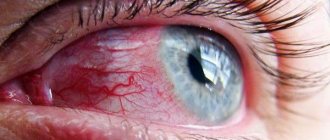Main causes, characteristic symptoms
Conjunctivitis is an inflammatory lesion of the conjunctiva of the eye, which is a consequence of penetration of a viral infectious pathogen into the mucosa. If the treatment of viral conjunctivitis is carried out incorrectly, it develops into a chronic form, which tends to recur at certain intervals. The disease manifests itself with characteristic symptoms:
- swelling and redness of the mucous membrane;
- itching, burning and pain;
- purulent discharge;
- feeling of a foreign body under the eyelid;
- formation of a dense vascular network.
How can you get infected with bacterial conjunctivitis?
How to distinguish this disease from other inflammatory lesions of the conjunctiva? Let us list the main symptoms of an infection that affects the connective membrane. Bacterial conjunctivitis occurs in both acute and chronic forms. In most cases, type 1 inflammation is diagnosed. It is characterized by the severity of symptoms. Inflammation develops first in one eye. He begins to itch and water. The patient feels as if a foreign body has gotten under the eyelids. There is pain in the eyeball. This is usually associated with increased sensitivity to bright light.
With staphylococcal conjunctivitis, mucus and pus are released from the eyes. The separated exudate has to be removed 6-8 times a day. The eyelids stick together in the morning and swell. Pneumococci cause inflammation, which is accompanied by severe itching and hemorrhages. They appear as red dots that are clearly visible on the conjunctiva. With gonococcal conjunctivitis, the connective tissue and eyelids swell so much that the eye closes completely.
A symptom specific to all types of bacterial conjunctivitis is a large amount of mucus and pus. These secretions contain bacteria. They may end up on a handkerchief, the patient’s hands, dishes, towels and any other objects. You can become infected with bacterial conjunctivitis by accidentally introducing germs to the conjunctiva. With such contagiousness, it is not surprising that after inflammation occurs in one eye, it subsequently spreads to the other.
What is conjunctivitis?
This term hides a disease that manifests itself in redness of the thinnest layer of the eye membrane (conjunctiva). In a healthy state, it is transparent; the main purpose of the element is to protect the whites of the eyes. The conjunctiva also covers the inside of the eyelids. The shell prevents dust and foreign objects from entering the organ of vision, moisturizes the eye and facilitates its movement. It contains a huge number of nerve endings, so at the slightest irritation, redness of the eyes is immediately observed.
Many factors can provoke the development of anomalies. A minor damage to the eye (for example, sand) or a weakened immune system is enough. Also, allergic reactions become the “impetus” for the development of the disease.
Varieties
The viral form of the disease is transmitted by airborne droplets. Considering the etiological origin, conjunctivitis in adults and children can be of the following types:
- Viral. Caused by adenoviruses, enteroviruses, and herpes viruses. The incubation period for an adult is 3-20 days, for a child - 7-10. It is during this period that the patient can infect others if he goes to public places and has close contact with people. With this form of pathology, clear discharge appears from the eyes and the temperature rises.
- Bacterial conjunctivitis. The main pathogens are streptococcus, mycoplasma, staphylococcus, chlamydia, trichomonas. The disease can spread from the patient more often through contact and household contact. In the bacterial form, purulent exudate is released from the eyes, this is the main difference from other types.
- Allergic conjunctivitis. It is safe for others, since its development is caused by an inadequate reaction of the immune system to the introduction of a foreign protein into the body. In addition to clear discharge from the palpebral fissure, the patient is worried about swelling of the mucous membranes of the nasopharynx, dry cough, sneezing, and difficulty breathing. After taking antihistamines, the symptoms cease to bother me.
Herpetic viral conjunctivitis
Herpes is also highly contagious. Some people believe that this virus is only transmitted through sexual contact. However, it is not. You can also become infected with herpes through a handshake. It is also transmitted by airborne droplets. Penetrates the body through the mucous membranes of the oral cavity or upper respiratory tract, passes through tissue, enters the blood, lymph and various internal organs.
As a result, herpes is integrated into the genetic apparatus of nerve cells, after which it is no longer possible to remove it from the body. The virus manifests itself during hypothermia or overheating, that is, at a time when the immune system is more vulnerable. A distinctive symptom of the pathology is the presence of blisters on the skin, lips, and eyelids. Viral herpetic conjunctivitis is accompanied by lacrimation, itching, swelling of the eyelids and conjunctiva. In the first days of illness, these signs cause particular discomfort. It is absolutely forbidden to scratch itchy eyelids. Because of this, the bubbles only become larger. In addition, you risk introducing an infection into the second eye.
Pathogens
Depending on the nature of the infection, bacterial, viral, and allergic conjunctivitis are distinguished in medicine.
If the disease is of a bacterial nature, then damage to the eye organ in adults may be associated with staphylococci, pneumococci, streptococci, Escherichia coli, gonococci, diphtheria and Koch bacilli. Viral conjunctivitis is characterized by the presence of adenoviruses and herpes viruses in the body.
If we talk about allergic conjunctivitis, the manifestation of symptoms of the disease is not associated with infection by bacteria and viruses, but with the ingestion of irritants that cause an immune response in the form of allergies. Medicines, cosmetics, household chemicals, dust, animal hair, and so on can provoke allergic inflammation of the eye.
Chlamydial conjunctivitis
One of the types of bacterial conjunctivitis. Most often it occurs against the background of a genital tract infection - chlamydia, although it can also develop due to chronic infections or a weakened immune system. Infection occurs through sexual intercourse, personal contact, the use of common hygiene items, and visiting public baths and swimming pools.
The following symptoms are characteristic of chlamydial purulent conjunctivitis: hyperemia and swelling of the eyelids, profuse purulent discharge from the eyes, which causes eyelashes to stick together, noticeable photophobia - the patient experiences discomfort in bright lighting. Vessels on the eyeball may burst, lymph nodes may enlarge, and even hearing loss may occur.
The danger of chlamydia is that it combines the properties of both bacteria and viruses, so the consequences for the visual organs can be more severe than with other forms of conjunctivitis. Thus, one of the types of these pathogenic microorganisms (Chlamydia trachomatis) causes severe eye damage if not treated promptly - trachoma. This condition is also called chronic keratoconjunctivitis. As it progresses, follicles and papillae form on the mucous membrane of the eyes, clouding of the corneal tissue and inversion of the eyelids occurs. They can turn in or out. The inflammatory process in the cornea (pannus) leads to clouding and loss of vision.
To treat acute chlamydial conjunctivitis in children and adults, antibacterial drops and ointments and glucocorticosteroid drugs are used to help eliminate the symptoms of the disease.
Is it contagious?
The highest rate of infection is characteristic of the adenovirus. The degree of contagiousness of an ophthalmic disease is determined by its etiology. The most dangerous and quickly spreading is adenoviral conjunctivitis, which is easily transmitted by airborne droplets and reaches the mucous membrane of the eye. When a person’s immunity is weakened at the time of introduction, within a few days the disease will manifest itself with characteristic symptoms. You can also become infected with conjunctivitis of a bacterial nature, but here you need to come into contact with objects that the carrier has touched. But the allergic form of conjunctivitis is non-contagious and does not pass from a sick person to a healthy person.
How to avoid getting conjunctivitis from a patient?
Healthy people in the apartment should have as little contact as possible with the sick person. However, when treating a sick child, it is difficult to avoid contact. You need to take care of him, help wash his eyes, drop drops, apply ointments. However, it is still necessary to allocate a separate room for it. Also, to prevent it from infecting others, it is recommended:
- buy the patient disposable tableware and handkerchiefs, which after use must be put into bags and thrown away;
- prepare a separate towel for the patient, which must be washed daily;
- move his toothbrush away from others;
- wash your hands with soap several times a day, especially after visiting the sick room;
- Boil pipettes and ointment sticks daily;
- ventilate the apartment at least twice a day;
- do daily wet cleaning of the premises;
- take vitamins to strengthen the immune system.
After the patient has recovered, you need to thoroughly clean the house, wash all the dishes, boil bedding and clothes. If you were wearing scheduled replacement contact lenses before getting sick, you should throw them away and buy a new pair. All these measures must be taken when treating an adult. It is important to complete the full course of therapy. Symptoms of the disease may disappear after a few days, but this does not mean that it has gone away completely. So, with viral conjunctivitis, even after complete recovery, a person can still be a carrier of the infection. If treatment is not completed, the risk of complications increases many times over.
Principles of treatment
Treatment depends on the nature of the disease. To identify the pathogen, you need to contact an ophthalmologist and conduct a series of laboratory tests. The specialist prescribes bacteriological and cytological diagnostics of smears from the conjunctiva. Additionally, consultation with an infectious disease specialist, allergist, or otolaryngologist may be required.
Antiviral drugs are prescribed to treat viral conjunctivitis. In this case, the type of pathogen is taken into account. During the day, it is necessary to rinse the conjunctival cavity with special antiseptic solutions and medications. If there is a risk of infection, antibiotic ointments and drops are prescribed. They inhibit the development of the infectious process and prevent complications.
It is forbidden to use bandages, as they impede the outflow of mucous discharge from the eye and can provoke the development of keratitis.
The patient needs to wash his hands more often and avoid household contact with healthy people. Bacterial conjunctivitis is treated with drops and ointments based on gentamicin and erythromycin.
Allergic inflammation of the conjunctiva is treated with antihistamines. They relieve itching, swelling, help get rid of discomfort and improve overall well-being. But in addition to medications, you can exclude any contact with allergens, which can weaken the effects of medications and cause repeated cases of the disease. Most often, the disease occurs in the spring months against the background of flowering plants. But exacerbation of allergies can also be caused by food, medications, aggressive cosmetics containing fragrances and dyes.
With the development of traumatic inflammation of the mucous membrane of the eyes, antimicrobial agents are prescribed to prevent infection. The conjunctiva is washed with antiseptic drops and solutions as often as possible - 3-5 times a day. You can additionally use infusions and decoctions of herbs (calendula, sage, chamomile, aloe juice and kalanchoe) as antiseptics. .
Main routes of transmission
The ways in which this disease spreads are varied, so the contagiousness of some types of conjunctivitis is high. Infection occurs in the following ways:
- Airborne. In this case, pathogenic microbes spread through the air, penetrate into the mucous membrane and begin active life there.
- Contact and household. To become infected, it is enough to shake the patient’s hand and then rub the eye or use infected objects, for example, a towel, cosmetics, or a handkerchief.
People with weak immune systems are most susceptible to the disease. These transmission routes are the main ones, but there are predisposing factors that can lead to infection:
- failure to comply with personal hygiene rules;
- unprotected sex life;
- decrease in the body's defenses.
How long is the incubation period?
When the mucous membrane is affected by a viral infection, the period of penetration and activation averages 5-12 days. In the first few days, the carrier may not be aware of the implantation, but as the disease progresses, the condition will gradually worsen. If a person’s immune system is weakened or the virus has entered the child’s body, then the incubation period is reduced to 8-12 hours. If the patient goes to work or school, the disease will begin to spread rapidly, taking the form of an epidemic.
Bacterial conjunctivitis, transmitted from person to another through contact and household contact, develops within 2-4 days after the introduction of infection. If treatment is untimely or incorrect, the disease will become chronic, which may recur several times over the course of a year and not go away for a long time.
Types of disease
There are four types of conjunctivitis:
- allergic;
- chronic;
- bacterial;
- viral.
As mentioned earlier, the first two types of the disease are not transmitted by contact. However, bacterial and viral conjunctivitis can easily be acquired through close contact with a sick child. The disease appears due to exposure to a virus or bacteria. The infection can be acquired in several ways. In order to become infected, it is enough:
- close contact with the patient;
- use of common things and household items;
- through a cough.
Viral conjunctivitis
This type usually occurs in children in the fall, when there is a sharp cold snap. Usually the disease develops against the background of a previous virus. A characteristic sign of the presence of this type of disease is that the eyes become purple. Treatment of eye pathology is lengthy compared to other types of conjunctivitis; it lasts for several weeks. If the disease appears, you need to contact a specialist at an ophthalmology center.
Is conjunctivitis contagious? How long does the disease last?
Pathology is transmitted from an infected person to a healthy person. At the same time, all types of diseases are fraught with danger, but each of them has its own “path”. In some cases, it is enough to rub your eyes with unwashed hands, and meet conjunctivitis in all its glory.
The duration of the anomaly depends on its type; there is no exact time frame for getting rid of the disease. No doctor can guarantee that you will be completely cured in ten days. As a rule, the illness lasts from five days or more. Do not postpone treatment until tomorrow; if primary symptoms appear, immediately seek medical help to avoid serious complications.
General principles of treatment of conjunctivitis in children
In case of conjunctivitis, the child should be at home on sick leave. Most of the varieties of this disease are contagious. If the sick person continues to go to school or kindergarten, he can infect other children. In addition, treatment may take longer. With bacterial and viral conjunctivitis, children under 7 years of age develop a fever. Therefore, they need to remain in bed. Even with allergic inflammation, which is not transmitted from one person to another, it is better to remain on sick leave, as the risk of introducing bacteria into the eyes increases.
Inflammation of the conjunctiva is often initially unilateral, but due to increased contagiousness, infection of the second eye almost always occurs. To prevent this, careful hygiene must be observed. All procedures - instillation of drops, application of ointments, washing of eyelids with solutions - are carried out on both eyes, even if only one hurts.
In a child, conjunctivitis can be accompanied by complications. Any ophthalmological disease can cause the development of another pathological process in the eyes, including the progression of a refractive error. This usually occurs due to untimely initiation of treatment, its complete absence, or early termination. Don't risk your children's health. Do not try to cure the disease with folk remedies, rinsing or moisturizing drops alone. At the first sign of conjunctivitis, take your child to the doctor.
Treatment of pathology
Since conjunctivitis is transmitted quickly from a carrier, during the period of therapy it is necessary to isolate the patient from others, provide him with separate linen, dishes, and hygiene products.
Drugs for treatment are selected only by an ophthalmologist. This will prevent you from becoming infected and preventing infection of another family member. The treatment regimen and method of use of medications are prescribed by a doctor; self-medication is prohibited. Groups of drugs used to treat different forms of conjunctivitis are:
- antibiotics;
- antiviral;
- antihistamines;
- non-steroidal anti-inflammatory drugs;
- glucocorticosteroids;
- multivitamins.
As an auxiliary therapy, it is useful to use natural remedies prepared at home. Herbal infusions and decoctions have a bactericidal and anti-inflammatory effect, which are recommended to be used as a basis for lotions, compresses and rinses. The list of medicinal herbs is as follows:
- chamomile;
- lingonberry leaves;
- St. John's wort;
- sage;
- cottonweed;
- centaury;
- yarrow;
- calendula;
- motherwort;
- series.
How the disease is transmitted in different groups
It all depends on the items that children use. As stated above, pathogens can land on a variety of things. Consequently, they will become the cause of the formation of the disease. Therefore, it makes sense to consider the main situations separately.
In kindergarten
Here the kids are in very close contact with each other. Therefore, the disease can be transmitted through towels, clothing, toys. Anything that touches the tears or pus of a sick child can cause illness.
In schools
In schools, infection often occurs due to cosmetics, clothing, and any accessories. For example, a child wiped his sore eye with his hand and accidentally smeared pus on the bag. Then another child held her. After which he rubbed his eye and the pathogen had already entered his body.
At home
Here, infection can enter through shared utensils, household items, and clothing. Bacteria are found on a variety of everyday items. There are simply no exceptions. The patient wipes his eye and touches the TV remote control. Through him, the infection will spread to another person.
On the street
Outdoor transmission is unlikely. To become infected, you need contact with secretions in the form of pus and tears. So, it is only possible to get sick with a viral form, for example ARVI, and conjunctivitis will already be a consequence of the development of this disease.
| However, transmission of bacteria on public transport is likely. For example, through handrails. Therefore, it is recommended to use antibacterial wipes when wiping your hands. |
Prevention
Conjunctivitis is a common ophthalmological disease that is easily transmitted through airborne droplets, as well as through contact with infected objects. Only allergic conjunctivitis is non-contagious; all other forms pass from the carrier to a healthy person. To prevent pathology, it is recommended to increase immunity, take multivitamins, observe personal hygiene rules, and not use other people’s hygiene items, cosmetics, and dishes. During periods of outbreaks of infectious diseases, it is better to limit your stay in public places; if there are characteristic symptoms of conjunctivitis, do not engage in independent treatment, but visit an ophthalmologist as soon as possible and undergo comprehensive treatment.
Main symptoms of conjunctivitis
The causes of inflammation of the conjunctiva can be allergens, microorganisms and various viruses that penetrate the membrane of the eye. Therefore, the disease is divided into allergic, bacterial, viral and fungal conjunctivitis. Despite the variety of causes, the symptoms of these diseases are almost the same.
Here are the main ones:
- hyperemia of the eyeball;
- lacrimation;
- itching, burning, aching pain;
- swelling of the eyelids;
- blurred vision;
- feeling of a foreign object in the eye.
These manifestations are characteristic of all types of conjunctivitis, the differences are only in the degree of severity. Symptoms first appear in one eye, then spread to the other, rarely affecting both eyes at the same time.
The child suffers from the disease seriously. He becomes lethargic, moody, sleeps poorly and constantly rubs his eyes. The baby develops a fear of bright light.
These are the first signs by which it is possible to assume that the disease is beginning. At the first suspicion of conjunctivitis, do not self-medicate under any circumstances. Contact your doctor immediately.
Transmission rate, complications
There is a misconception that pathogenic microorganisms take time to jump from a sick person to a healthy one. This is wrong! It only takes them a second to infect you. The anomaly also develops at a rapid pace, in some cases, primary symptoms appear an hour after contact with an infected person.
If you ignore the disease, hoping that in a week it will go away on its own, destructive processes will begin in the visual system that cannot be corrected. Tissues are affected, ophthalmological abnormalities are activated, visual acuity decreases, and the risk of blindness increases.











